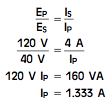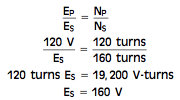Auto transformers are one-winding transformers. They use the same winding for both the primary and secondary. The primary winding in the image below is between points B and N and has a voltage of 120 volts put on it. If the turns of wire are counted in between points B and N, it can be seen that there are 120 turns of wire. Now assume that the selector switch is set to point D. The load is now linked in between points D and N. The secondary of this transformer consists of 40 turns of wire. If the quantity of voltage put on the load is to be calculated, the following formula can be made use of:
Auto transformer calculations
Presume that the load linked to the secondary has an impedance of 10 ohms. The amount of current flow in the secondary circuit can be computed making use of the formula:
The primary current can be computed by using the same formula that was utilized to calculate primary current for an isolation sort of transformer:
The quantity of power input and output for the auto transformer must coincide, just as they are in an isolation transformer:
Now assume that the rotary switch is connected to point A. The load is now linked to 160 turns of wire. The voltage put on the load can be computed by:
Notice that the auto transformer, like the isolation transformer, can be either a step-up or step-down transformer.
If the rotary switch revealed above were to be gotten rid of and replaced with a sliding tap that made contact straight to the transformer winding, the turns ratio could be adjusted continuously. This kind of transformer is commonly described as a Variac or Power-stat depending on the supplier. A cutaway view of a changeable auto transformer is revealed below. The windings are coiled around a tape-wound toroid center inside a plastic case. The tops of the windings have been milled flat to offer a commutator. A carbon brush makes contact with the windings.
Auto transformers are often made use of by power companies to provide a little increase or decrease to the line voltage. They help offer voltage law to big power lines. The auto transformer does have one drawback. Because the load is connected to one side of the power line, there is no line isolation between the incoming power and the load. This can trigger problems with particular sorts of equipment and have to be a factor to consider when making a power system.
Check out our Facebook Page Here!







